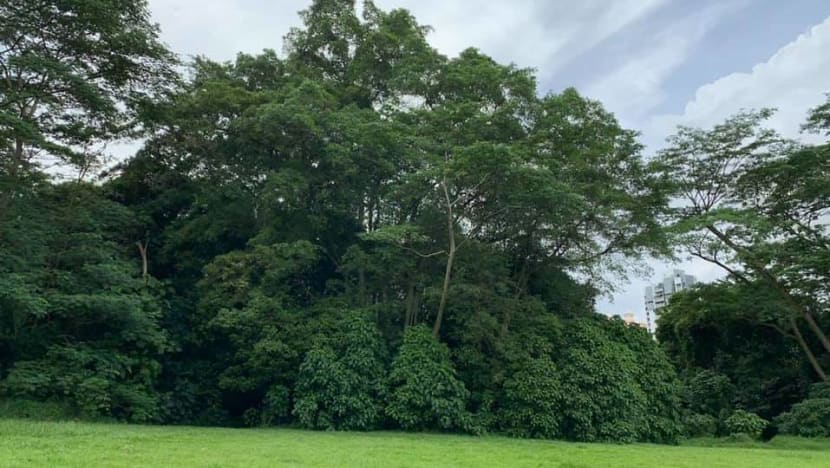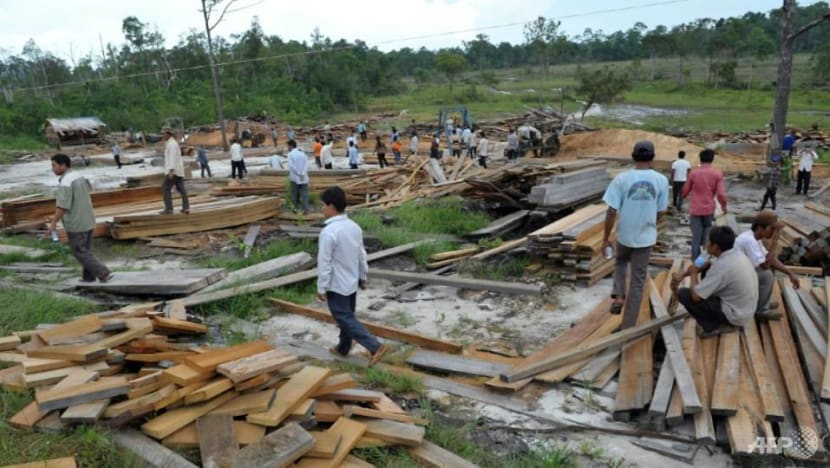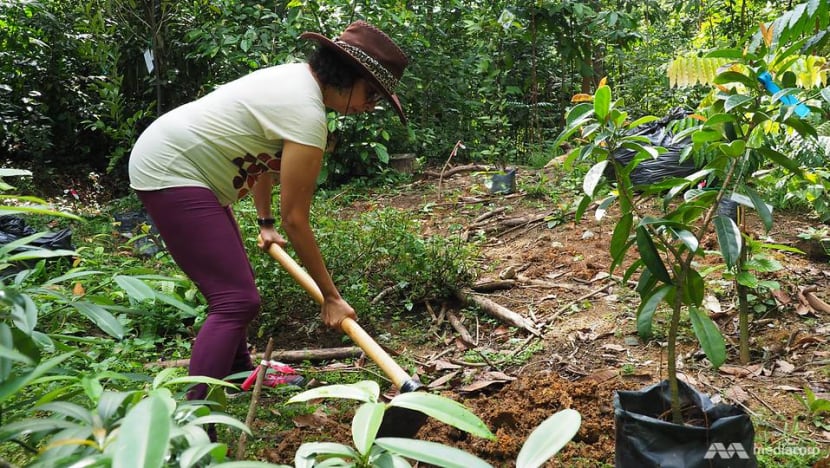commentary Commentary
Commentary: Planting trees is a safe climate action but are its benefits inflated?
With reforestation becoming a popular choice for companies and governments’ sustainability programmes, misconceptions abound over what makes tree planting truly valuable for both people and the planet, says a sustainable development consultant.

Dover Forest. (Photo: Facebook/Desmond Lee)
SINGAPORE: Planting trees has long been described as a strategic and “politically safe” climate action.
Targets for the Singapore Green Plan 2030 announced on Feb 10 included planting 1 million trees by 2030. Elsewhere, the UK government has pledged to plant 30,000 hectares of trees annually until 2025.
Even notorious climate change denier Donald Trump committed the US’ support for the World Economic Forum’s One Trillion Trees initiative when he was in office.
The argument is simple: Trees store a large amount of carbon, so planting more of them will help remove significant amounts of planet-warming greenhouse gases from the atmosphere.
Amidst an ongoing debate about reforestation, scientists however, are now arguing that the climate benefits of tree planting are inflated, while the potential adverse social and environmental impact is downplayed.
READ: Visitors to Clementi, Dover forests should be mindful of trees prone to falling: SLA, NParks
A scientific estimate that we could plant enough forests to store 205 gigatonnes of carbon – equal to one-third of all emissions produced by humans so far - was met with criticism for overestimating the land suitable for tree planting, including areas where native ecosystems or indigenous livelihoods would be disrupted.
In addition, predicting the amount of carbon absorbed by forests is extremely challenging and vary based on a multitude of factors such as tree species, climate or soil quality.
Many also claim that planting trees distracts from the more pressing need to phase out fossil fuels which account for the majority of greenhouse gas emissions.
The sheer number of ambitious tree planting initiatives launched in recent years is encouraging but it’s critical that we understand that planting trees offers no panacea to climate change, and if done wrongly, could actually harm the planet.

The world’s largest afforestation project – cultivating trees where none has grown before - spearheaded by China is a prime example of a tree planting initiative with mixed results.
Launched in 1978 to fight desertification in the north of the country, the Three-North Shelter Forest Programme, also known as Great Green Wall, set out to grow 87 million acres of forests, equivalent to the size of Germany, by 2050.
Under political pressure to show quick results, efforts were focused on planting monocultures of fast-growing poplars. While forest coverage has almost doubled, planting a single, non-native species in a dry region attracted pests and diseases, causing many of the trees to die, whilst also exacerbating water scarcity and destroying existing ecosystems.
READ: Singapore to plant 170,000 more trees in industrial estates over the next 10 years
The project did learn from its initial missteps, and the second phase focuses on natural forest regrowth and engaging local communities for improved maintenance of the forests.
A middle ground can be found in the wisdom of organisations that have long looked at the challenge of reforestation like the Royal Botanic Gardens, Kew in the UK. They’ve listed a few guiding rules that may be helpful.
PROTECT EXISTING FORESTS FIRST
Countries and organisations which destroy natural forests for agricultural or industrial use cannot make up for the biodiversity damage and carbon emissions caused by planting trees elsewhere - keeping forests in their original state should always be a priority.
In Singapore, greater public awareness has also led calls against clearing forests for housing and industrial development – most recently over Kranji, Dover and Clementi forests.
In Indonesia, the Bukit Barisan Selatan Sustainable Commodities Partnership (BBS KEKAL) exemplifies the delicate balance required between safeguarding existing forests and ensuring sustainable livelihoods for local farmers without deforestation.
Bukit Barisan Selatan National Park (BBSNP) in Southern Sumatra is one of the last remaining habitats of the critically endangered Sumatran tiger, rhino and elephant, yet is under threat due to agricultural expansion.
An estimated 10 per cent of the park is under active coffee cultivation, contributing up to 5 per cent of Indonesia’s annual coffee production.
Through training and incentives such as preferential access to finance and markets, BBS KEKAL aims to improve the productivity and profitability of smallholder coffee farmers on their existing land, reducing the need to cut down more trees, and supporting a transition to deforestation-free coffee production.
CHOOSE THE RIGHT AREA TO REFOREST
Authors of the Kew research also suggest prioritising natural regeneration, the process of natural forest regrowth, either by simply protecting the area from further damage, or with appropriate human intervention.
READ: Native species, community engagement: Why there's more to planting trees than digging and watering
Natural regeneration can be more cost-effective and efficient compared to building a man-made forest from scratch, especially if the degradation is minimal, natural vegetation is still present, or the area is located close to another forest that can serve as a seed source.
Where natural regeneration is not feasible, scientists at Kew recommend that reforestation focus on previously forested areas that have suffered degradation, or expand an existing forest by connecting it to the reforested site.

In dense urban places such as Singapore, the National Parks Board (NParks) is planting trees and shrubs along sidewalks to create so-called “nature ways”, which connect and facilitate the movement of animals like birds and butterflies between green spaces, and replicate some of the habitat value of natural forests in an urban setting.
It’s also critical to identify “no-go zones” for reforestation. These include naturally tree-less snow-covered areas such as tundras that provide a cooling effect on the planet by reflecting the sun, or in the case of Africa and tropical or subtropical Asia, savannas and wetlands which already contribute to capturing carbon, mostly in the soil.
SELECT THE CORRECT TYPE OF TREES TO PLANT
Choosing the right type of trees will ensure greater biodiversity conservation and more resilience towards pests, disease, extreme weather events and climate change.
Instead of monoculture tree plantations that might cause soil erosion and degradation, experts suggest focusing on planting a mix of trees, including native, rare, endemic or endangered species.
It’s also crucial to select species that are able to form mutually beneficial relationships with the surrounding flora and fauna, including fungi, pollinators and seed-dispersing animals.
Native species which have a better chance of surviving unfavourable conditions in a heavily damaged site should be prioritised. NParks, for instance, selected various types of native coastal and back mangrove tree species, two of which are critically endangered in Singapore, as part of its mangrove restoration efforts.
Exotic species, such as acacia or eucalyptus, might be promoted for their higher commercial value or because of their fast-growing nature, but often become invasive, meaning that they take over natural habitats, compete with native species, reduce biodiversity and water availability.
READ: Commentary: Let Singapore’s green spaces grow wild
One example of this is in Isan, one of the poorest regions of Thailand where tropical forests were cleared to harvest eucalyptus as feedstock for paper mills, but the non-native species diminished soil quality and drained all the water, making it impossible for any other crops to grow.
Eventually even the eucalyptus trees failed to survive or were cut down, leaving the forest barren and the soil chalky. Villagers who used to source native medicinal plants or seasonal food from the forest, struggled to look elsewhere for income or food.
ENGAGE LOCALS AND COMMIT TO LONG-TERM SUPPORT
Lack of community involvement is often cited as the key reason why reforestation projects fail. If the land considered for tree planting has been used as a source of livelihood by locals, they might resort to cutting down trees elsewhere or try to retake the land once the trees have been planted.
According to Marie-Noëlle Keijzer, co-founder of non-profit WeForest, projects should last a minimum of 10 years for local populations to reap the benefits of preserving cultivated trees, in contrast with “plant and go” schemes which leave the responsibility to care for the trees to local communities.

The NGO Eden Reforestation Projects employs local villagers in its reforestation projects to provide them with an economic incentive to safeguard the trees, and invests a percentage from the cost of each tree to hire forest guards for the long-term protection of the forests.
READ: Commentary: Save forests or build 4-rooms? It’s not a zero-sum game
“Reforestation is more than just about the number of trees and tree planting. You can't just plant or restore a tree and leave it, or expect that restoration without protection is sufficient to reach our climate goals”, says John Lotspeich, Executive Director at Trillion Trees.
This list is not exhaustive but it is important that we understand why we are planting trees, and if they are the right ones at the right place.
Tree planting is an undoubtedly valuable solution to mitigate climate change, but reforestation cannot be a cure-all. It must be combined with efforts to protect existing forests, tackling the root causes of deforestation and cutting carbon emissions at source.
Could conserving green spaces lead to more dangerous wildlife encounters? Conservationists and an NParks director weigh in on CNA's Heart of the Matter podcast:
Trang Chu Minh is a consultant on international development projects on topics ranging from climate change mitigation to inclusive education.














